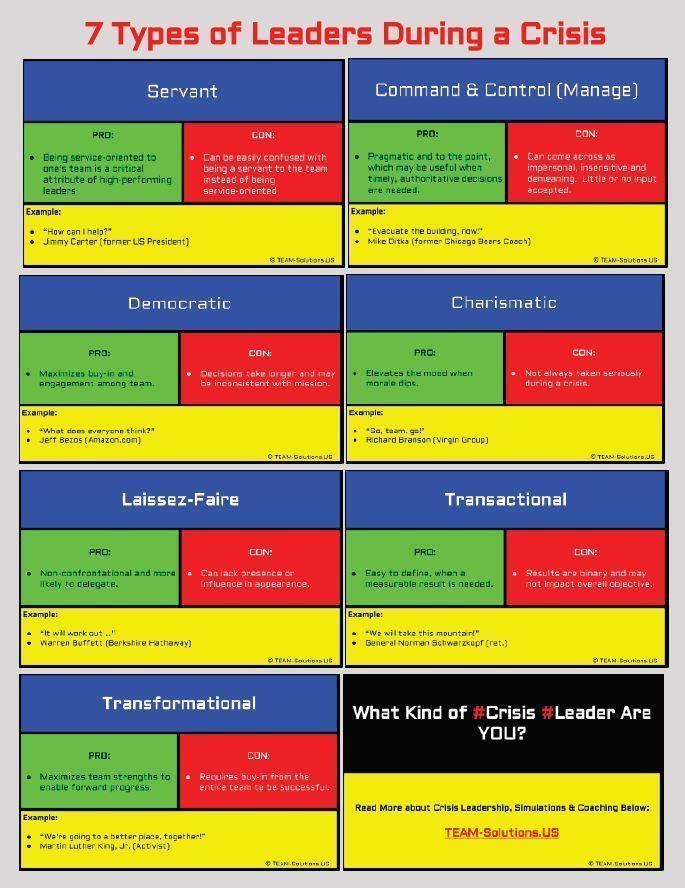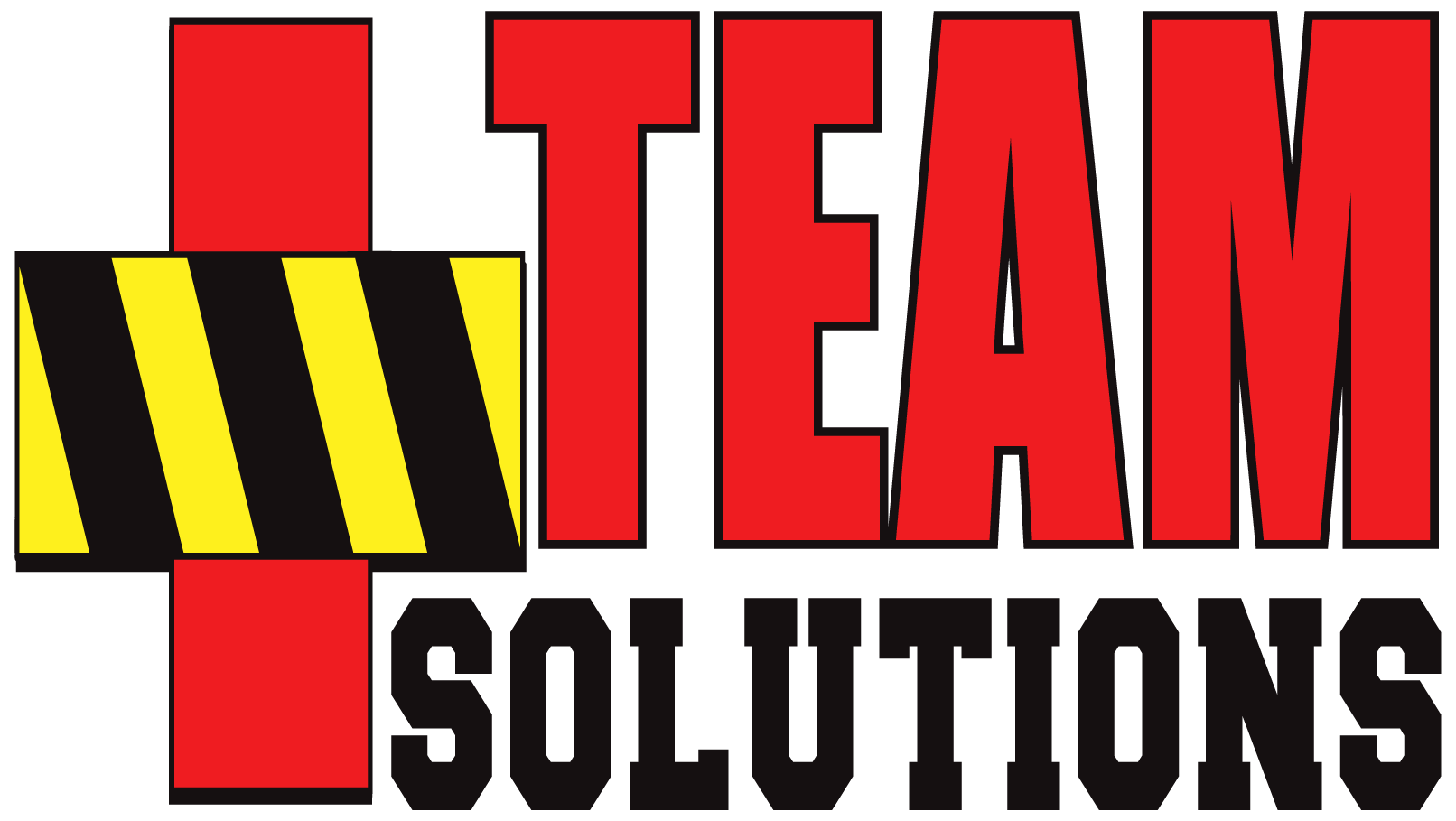In the movies, the heroic leader is often seen charging at the enemy with their saber rattling and a fierce battle cry.
Just like in real life, right?
Uh, no.
Theater aside, success during a crisis requires a leader that can access different strengths at different times.
Read on about the different leadership types in a crisis ... and consider which ones you excel at and which ones you want to improve.
“The questions we ask ourselves determine the type of people we will become.” ~ Leo Babauta
Labels are good for knowing if you’re about to accidentally sprinkle salt instead of sugar on your cobbler, but not so good for describing people.
Labels on people are sometimes restrictive, inconclusive, and demeaning.
There are some helpful exceptions though. To solidify our leadership capacity, evaluating the characteristics and tendencies of the behavior associated with a particular leadership type guides us and others how best to interact with them.
For example, if you know that a leader you are reporting to is ‘all about’ the command and control aspect of their position, then your strategy in dealing with them should be different than if they were more of a laissez-faire leader.
Let’s break down some leadership types by, yes, labeling them by their characteristics. Many leaders will embody more than one style, too. They’ll tap into the style that works for them depending on the situation at hand.
Therefore, I encourage you to study all of them and consider taking the best part of each one to add to your growing Crisis Response Leader duffel bag.
1. Servant Leader
Servant leadership is very popular these days. A recently promoted fire chief proudly told me recently that he was now a servant leader, and that at fire scenes he now stays “in the rear with the gear” in case there is a need for him to be a servant for his Captains fighting the fire ‘up front.’
Similarly, when Jimmy Carter was elected President of the United States in 1976, he saw himself as a servant leader before the term became popular. He went as far as insisting that he carry his luggage into the white house on move-in day, in full view of the press corps who widely broadcast and reported the new president’s selfless act of ‘servitude.’
Except that it backfired. It took quite awhile for President Carter to earn the respect of many American’s and many elected politicians in the USA and abroad. Many believe it is because he chose to focus more on being a servant rather than being a service-oriented leader. There is a distinction, and it often makes the difference between being effective as a leader and being ineffective.
I’m not a big fan of the common portrayal of servant leadership. Good leadership is not about servitude; it’s about service.
Example:
During our response to Hurricane Katrina in New Orleans, our Response Leaders faced a daunting task: lead us into and safely out of those horrific conditions while helping as many people as possible. They were unwavering in their focus, relentless in their expectations and supportive of our efforts. One of our hardened and steadfast leaders started out each day bringing us each a cup of hot coffee, a smile, and an encouraging word to our tent every morning. He didn’t have to serve us coffee with a smile, yet his selfless service helped us ‘get our head right’ about the tasks that lay ahead.
His actions provide a simple but effective example of service-oriented leadership.
2. Command and Control Leader
You’ve also heard this kind of leader referred to as an autocratic, coercive, or authoritative leader.
The image people conjure of a command and control leader is a uniformed officer pounding their fist on the table and yelling directions at their subordinates while they huddle in fear.
While that may be true, there are also many times when we need someone with absolute authority and the presence to command and control an environment.
Example:
If the ship is sinking, the captain that will save the most lives is the one unapologetic-ally barking evacuation instructions to the crew.
However, that same style of leadership is not a good fit when the captain is coaching his kid’s Little League game on the weekend.
Therefore, a little bit of command and control goes a long way.
Note: modern incident managers often modify this leadership label from “command and control” to “command and manage.”
3. Democratic Leader
Democratic leaders tend to give everyone a voice to share their opinion. This all-hands approach can do wonders for engagement and participation since more people feel that they have a say in what happens next.
The downside is that ‘group-sourcing’ decisions can take a great deal of time before making a decision.
4. Charismatic Leader
The charismatic leader boosts morale and is often their organization’s number one cheerleader.
This style is ideal when a happy face is needed to represent the organization, like Virgin Group founder, Richard Branson.
Charismatic leaders are seen on stage leading the pep rally and inspiring new initiatives. Their downfall is when, particularly during a crisis, they attempt to be serious, which may appear to be forced and lacking in authenticity.
5. Laissez-Faire Leader
This leader is fond of saying “it will work out” without having a plan for it to work out. Of course, when it works out it’s because someone was decidedly not laissez-faire about it and took care of business.
Acting in a hands-off, non-intervening way can often be helpful for a leader, but being absent too often isn’t leadership, it’s called a vacation.
The good news is that behind the behaviors that define the different leadership types, they are all just labels. And labels do not define how effective we are as Response Leaders.
In fact, the most successful leaders tend to embody several styles of leadership and rely on the most appropriate style based on the situation at hand.
Example:
An example is very well-known military leader James Mattis.
He has demonstrated proficiency in many of the different leadership types, but only one at a time, depending on the situation.
In his own words:
"America has two fundamental powers. One is the power of intimidation. I was part of it and America will defend herself and our idea, this experiment that we call America. And that's all it is, is an experiment in democracy. But the other power I think that perhaps we have used less in recent years, last 20 years maybe, is the power of inspiration. And I think that the power of inspiration of America at times has got to be employed just as strongly." ~ Retired Marine Gen. James Mattis
6. Transformational Leader
7. Transactional Leader
Response leaders always have their eye on the prize. And by the prize, I mean the result of accomplishing the mission priorities and objectives.
Example:
Say the objective is to go to a parlor to get ice cream.
Even in the face of road closures, screaming kids and an impending kick-off of their favorite team’s game, the Response Leader always has a mental image of what it will be like to slurp up some Rocky Road ice cream.
It takes practice to refine the mental images, but when what we imagine becomes real, it’s all worth it.
By sharing those images and bringing the mission to life for others, a Crisis Response Leader can become transformational.
Transformational Leader:
"helping people transform from their current condition to a better condition."
You’ll hear them also referred to as change agents, coaches, and mentors.
“If you want to build a ship, don't herd people together to collect wood and don't assign them tasks and work, but rather teach them to long for the endless immensity of the sea.” ~ Antoine de Saint-Exupéry
Transforming can lead to an ideal state, but there’s an evil twin of the transformational leader called a transactional leader.
Transactional Leader:
"leading someone based on specific, short-term tasks."
Example:
Instead of helping them envision the cool taste of ice-cream despite any obstacle, transactional leaders focus instead on managing the task of driving in traffic, of getting home before the game starts, of suppressing the kid’s outbursts,
- Transactional leaders focus on what’s measured, i.e., time in traffic, quiet versus noisy children, etc.
- Transformational leaders focus on the future condition, i.e., growth, strategy, and vision.
Perhaps the definitions were helpful, but they hardly matter.
What is important is that the Crisis Response Leader understands what results they should expect when they’re transactional versus when they’re transformational.
Here’s another more salient example of the Crisis Response Leader who’s approaching their work as a series of transactions and the actual outcome they create:
Example:
The Browerville Fire Department has 24 stations so far in service to their growing community. The Browerville Chief has been under pressure by the city manager to maintain and in some cases lower costs to maximize the funds available for the city’s growth initiatives.
During the chief’s regular visits to each station, the chief makes a point to address and question:
- The extra medical training supplies consumed
- The water bill being higher than normal
- The overtime paid to some of the firefighters
The captains explain that:
- The extra training supplies were to address a noted deficiency in some of the medic’s bandaging skills by doing some in-service training
- The higher water bill was because of the extra washing of the fire apparatus so that they are clean during the increased visits by the public and local politicians (including the city manager)
- The overtime was used to help mentor junior officers so that they’ll be ready to promote when the number of fire stations expands
The chief doubles-down on the cost-cutting and demands that they do more with less. The chief requires the delivery of daily reports to his office for overtime, training supplies, and water usage by noon each day for review and feedback.
The firefighters begin to lose trust that the chief has their best interests in mind. The resentment they feel toward the chief continues to grow, and the productivity increases that the chief demanded begins to decrease.
- Productivity is low.
- Morale is low.
- The Browerville Fire Department is in turmoil and becomes one of the last city departments to receive budget consideration.
The chief’s extreme focus on productivity has created three (3) party fouls common to transactional leaders:
- Micromanagement
- Lack of vision
- Too much focus on productivity
The story helps to frame how those fouls can appear slowly but can grow until the ripping fibers of the organization can be heard a mile away.
The unfortunate reality is that while the execution failed, the intent may likely be valid:
- Large and growing organizations need managing, just not micro-managing.
- Near-term vision can also help sustain the long-term vision.
- Productivity that gets measured can also be productivity that gets funded.
Let’s look at some root-causes:
- Perhaps the chief was ill-equipped to be a better advocate for their department in budget meetings?
- Perhaps the chief was also personally burdened with having to provide consistent evidence of productivity?
- Perhaps the leadership environment in the whole city has inadvertently fostered a transactional approach?
- Except for a few notable exceptions, most people don’t intend to perform poorly at their job.
However, it’s also quite easy to overlook and accidentally reinforce some of these subtle, destructive behaviors until they bubble to the surface.
Possible Solutions:
- Assessing the path that these transactions took can help find the root.
- After unearthing the source of this transactional approach, seek to understand the WHAT and the WHY of this method.
- Suggest a combined effort to transform the WHAT and the WHY into objectives that everyone can get behind.
- Become an active leader in the transformation from the WHAT and the WHY to the result that everyone supports.
So, what kind of leader are you?


